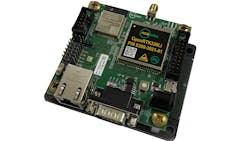ACEINNA Launches GNSS/INS Localization Solution
This article appeared in Evaluation Engineering and has been published here with permission.
ACEINNA's OpenRTK330L is a low-cost, high-performance triple-band RTK/GNSS receiver with built-in triple redundant inertial sensors. Designed to replace the expensive and bulky precision RTK/INS systems used in today’s autonomous systems, this compact navigation solution meets the challenging performance, reliability, and cost requirements of the automotive market along with the needs of robot, drone, construction, and agriculture systems.
“The combination of a triple-band GNSS receiver and a high-precision IMU has enabled us to make a remarkably accurate, small, reliable, and cost-effective GNSS/INS solution,” said Mike Horton, CTO of ACEINNA, which unveiled the receiver at last month CES 2020. “The OpenRTK Precise Positioning Engine optimizes satellite tracking and high RTK fixes rates while integrating seamlessly with ACEINNA's open-source, developer-friendly Open Navigation Platform.”
ACEINNA’s OpenRTK330L includes a triple-band RTK/GNSS receiver coupled with redundant inertial sensor arrays to provide cm-level accuracy, enhanced reliability, and superior performance during GNSS outages. The OpenRTK330L integrates a precise 2°/h IMU to offer 10 to 30 seconds of high-accuracy localization during full GNSS denial. This enables autonomous system developers to safely deliver accurate localization and position capabilities in their vehicles at prices that meet their budgets. OpenRTK330L's embedded Ethernet interface allows easy and direct connection to GNSS correction networks around the world. OpenRTK330L's CAN bus interface allows simple integration into existing vehicle architectures.
The multiband GNSS receiver can monitor all global constellations (GPS, GLONASS, BeiDou, Galileo, QZSS, NAVIC, SBAS) and simultaneously track up to 80 channels. The module has RF and baseband support for the L1, L2, and L5 GPS bands and their international constellation signal equivalents.
The inertial measurement unit and dead-reckoning function contains a total of nine accelerometer and nine rate gyro channels based on ACEINNA's triple-redundant 6-axis IMU array. By integrating a triple-redundant IMU array, the OpenRTK330L is able to recognize and utilize only valid sensor data, ensuring high-accuracy protection limits and certifiability under ISO 26262 standards.
The receiver is supported by ACEINNA’s Open Navigation Platform allowing custom embedded application development on top of ACEINNA's positioning engine and dead-reckoning algorithms. Autonomous solution developers have full access to all resources on the OpenRTK330L module, including the GNSS receiver measurement data, IMU measurement data, and all interfaces. Specifically, theGNSS receiver supports GPS (L1 C/A, L2C and L5), GLONASS (L1OF, L2OF), BeiDou (B1I, B2I), GALILEO (E1, E5a, E5b, E6) QZSS (L1 C/A), and NAVIC.
The IMU sensor array includes a triple-redundant, 3-axis MEMS angular rate sensor and a triple-redundant, 3-axis MEMS accelerometer. Also in the mix are Ethernet, UART, SPI, and CAN interfaces for versatile integration into a host system. Additional specifications include operating temperature range of -40 to +85°C and qualification to standard automotive shock and vibration levels.
